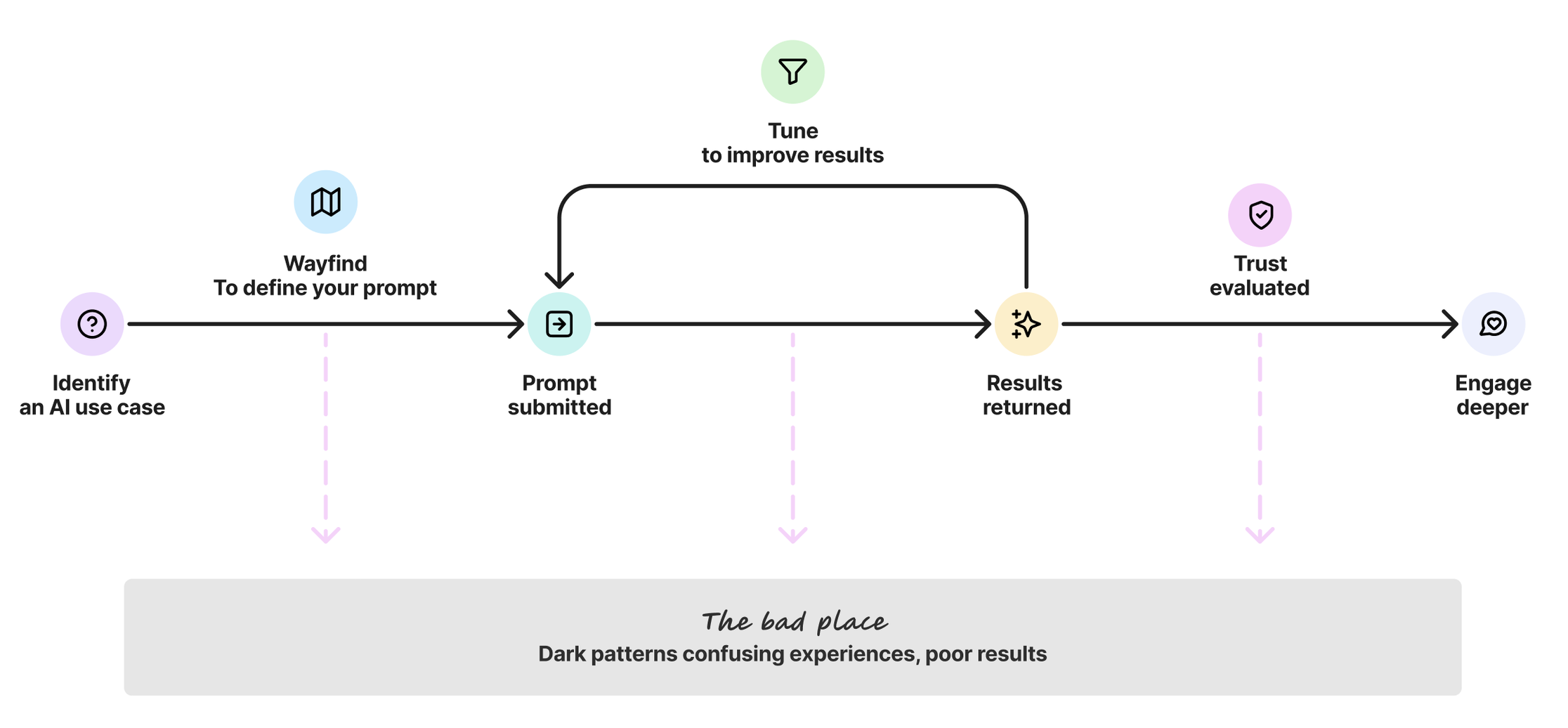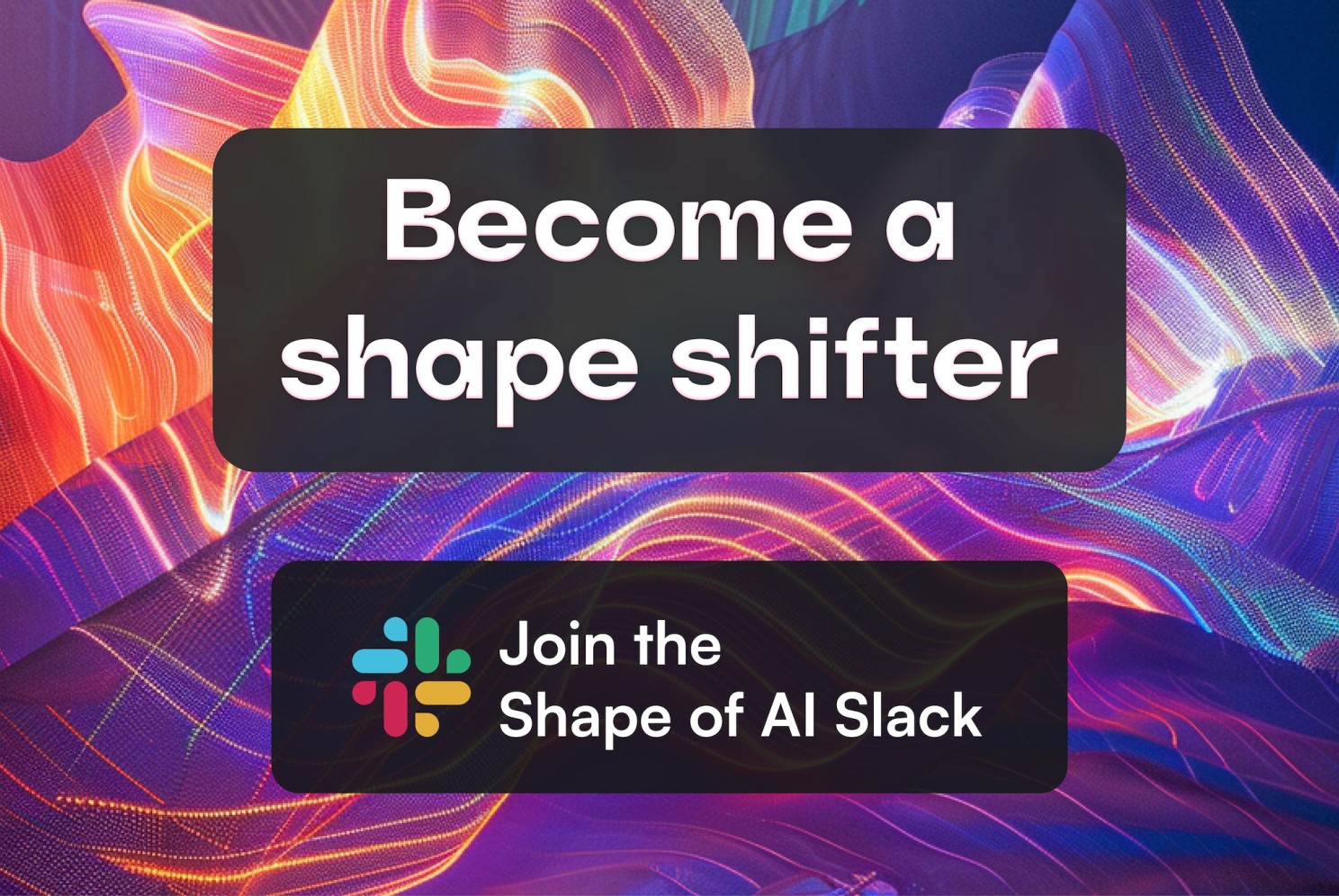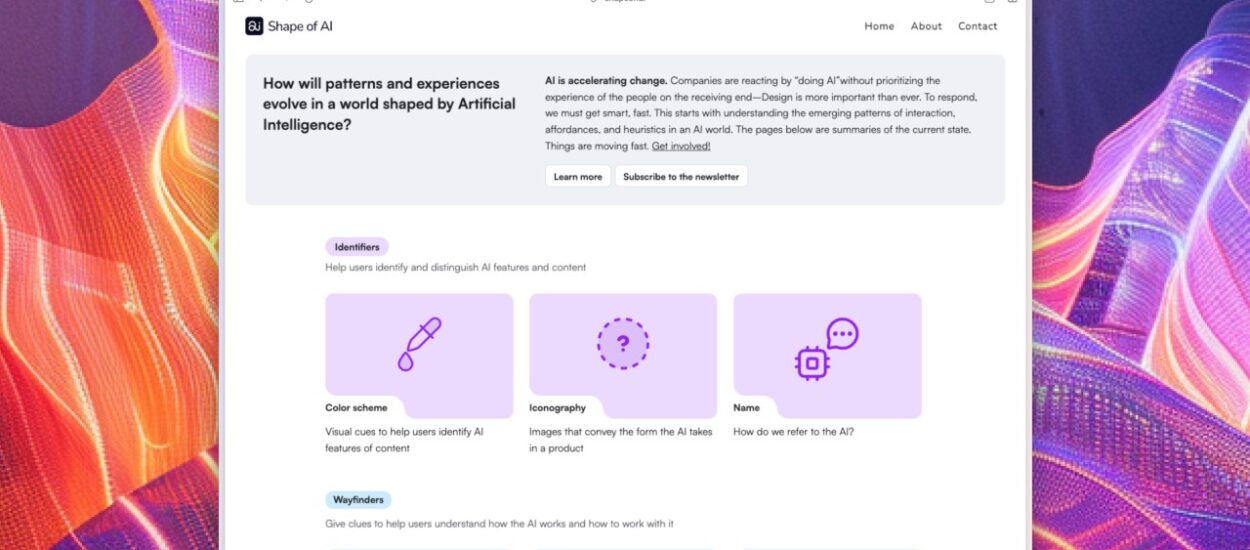A new pattern language for a new paradigm shift
BLUF: Product development in AI is accelerating faster than we can keep up. This is already leading to fragmented experiences and feature bloat. Design is more important than ever–but how can navigate these changes at the pace of the market? We need to combine forces, and re-think common interface and interaction patterns for this new medium. I’ve started this process, but I need your help.
Today I’m launching ShapeOf.AI– a documentation library of the emerging and adapting patterns already showing up in products using AI. What’s missing? What needs to change? What are you seeing that I’m not?
Please join me on the journey. This moment is an opportunity to reset our approach to technology, and to redesign design as a discipline. Hop on. ❋
Everything everywhere all at once
AI feels like it’s everywhere, and it’s accelerating fast.
As features get baked into products, and new products appear en masse, the window is closing to take a thoughtful and collective approach to evaluate what interaction design looks like in this new medium.
What parts of the old paradigm make sense. What needs to change? What needs to be invented?
Design is more important than ever. If we don’t take a stab at walking into this together, we’ll find ourselves playing catchup.
Honestly, we already are.
We’re in a race to the starting line. Companies are prioritizing “doing AI,” but struggling to gracefully integrate it into their current products. It’s not clear if they are taking the time to assess how a feature should work, why it should work that way, and if it should even exist.
A new interaction paradigm
Things aren’t all lost. Digital interactivity has evolved before.
- In the mid 20th century, people went from being the computers to training the computers.
- In the latter half of the century, we moved from training computers to interacting with them through GUIs. We no longer had to memorize code to get a computer to do what we wanted it to.
- In the late naughts, digital experiences went from being static to dynamic through algorithmic news feeds and cross-platforms integrations. We no longer could predict exactly what content someone would see at any given time within the same context.
- And now we are in a world where we are back to programming computers to do what we want them to do, but the list of possibilities has multiplied by a massive factor.
In each of these moments, many of our old patterns didn’t make sense any more. Some made things worse. Some required changes in patterns upstream: to how we organize, learn, and work together.
This time feels different though. It’s happening so fast! And it’s happening right under our noses. Here’s how I know…
The patterns of AiUX
[Side note, I’m going to use AiUX to refer to patterns and interactions that are specific to the AI medium]
I’ve spent the last month cataloging emerging patterns in AI products. After wading through 40 or so different “solutions” on the market, there’s one thing I can say for sure.
Things are a mess.
Products have lots of cool stuff in them. But the stuff is not consistently aligned to a journey. And the stuff differs from experience to experience. This results in fractured products and confusing interfaces.
…But I think there might be something worse happening.
Our limited understanding of AiUX patterns is restricting our ability to imagine and create products that are different from what’s already available. We are limiting our ability to innovate our experiences at the pace of change to the business and computational models powering the products themselves.
As AI becomes increasingly integrated into digital products and services, the design of AiUX interactions will dictate the success and user adoption of these products.
However, if we fail to define and adopt new AiUX interaction patterns, relying instead on patterns established under heuristics for an old interaction model, we may be limiting the scope of innovation. This approach confines designers to a commodified box of existing solutions, and hinders the exploration of novel and potentially more effective interactions.
Our limited understanding of these emergent UX patterns lis limiting our ability to think beyond the commodified patterns (and therefore products) currently on the market
It’s like trying to build a rocketship with materials developed to build a car. At some point, they are going to break.
Let’s start here: What is the journey of AiUX?

AI interactivity is a motion of sense and respond. We can’t see under the hoods of what is happening beneath the interface. The only way we can get better results from AI is by first getting bad results from AI.
This is what I mean when I ask, what if we reframed AI as discovery?
That’s what users of digital products are encountering. BUT – they are used to predictable results, not working with the computer to product a result together.
We suffer from automation bias. We trust the machine. So if the machine gives us a bad results, or incorrect results, it feels dissonant. It’s uncomfortable. And in many cases we don’t know how to respond. We don’t know that we CAN respond.
It’s the responsibility of the AI to guide users forward in their journey. AiUX must move people forward. It’s not sufficient to provide stuff and then fail to provide a way to improve that stuff.
There are emerging patterns that work this way.
For example, nudges early in the journey can help users construct stronger prompts up front. Templates that show users how parameters can help them tune their output teach them how the technology works while creating a good experience from the start.
The Role of Designers in an AI World
Designers working with AI are not just creators of visually appealing, usable interfaces. Designers need to be architects of experiences, curators of human-machine interaction, and, importantly, mediators between complex algorithms and users.
Our role is to make AI accessible, usable, and beneficial by translating its capabilities into applications that address real human needs and preferences.
In addition to adopting new AiUX interaction patterns, we need to revisit our patterns of work as well.
- Treat users like co-creators: Designers can no longer be on the receiving end of customer insights processed by someone else. We must make time in our process to get close to the people using the AI. Their unspoken preferences will manifest in their results. We need to be prepared for them.
- Learn like a liberal arts major: As interactions with technology get closer to feeling human-like, liberal arts disciplines can provide critical perspectives on how humans interact with technology. Psychology, Anthropology, and even philosophy teach us how human behavior adapts to unseen inputs and forces, similar to how AI will adapt to its inputs, we will collectively adapt to the presence of AI.
- Think like a scientist: How can we get out of the cycle of production. We need to be more comfortable viewing failure as a learning opportunity and not as a setback. Remember, improving our interactions with AI starts with bad interactions. This is the same as with humans. We learn emotional intelligence, social skills, etc through uncomfortable experiences as much as with comfortable ones. Designing with AI will be emergent and chaotic. We need to adapt our practices to accept that.
- Prototypes as a super power: I’m stuck on this one. What do prototypes look like in AI world. If nothing else, designers must get comfortable with prompt engineering. We need to understand how the computer is talking to itself when its returning results to people. If you haven’t read John Maeda‘s book How to Speak Machine, stop what you are doing and go buy it. Rapid prototyping will be critical to help us fail and learn fast. We must learn the rules of computation to expand this skill.

My vision
The Shape of AI exists to help make the technology and impact of artificial intelligence more understandable, so that collectively we can influence a future where technology enhances our life, instead of causing harm.
This is a work in progress. Every pattern I describe in this project represents a summary of current trends in usage, and best practices that are emerging – but from MY perspective.
I need yours!
I have tunnel vision. I’ve been staring at this for too long. If you see something you disagree with, or something I’m missing, I want to hear about it.
This list will continue to expand to include additional prompt types, UI patterns, settings options, and more. Additional pattern categories will include heuristics, evaluation and prototyping, and business use cases.
I’ve set up a Slack for us, the Shape Shifters, the people changing ourselves so we can change the world around us.
Join, and share what you’re seeing.

This is messy, and emergent. It has to be. On the other side of this work is a new understanding of interaction design. A new definition of what it means to be an interaction designer. A new structure for design and discovery. A new operation plan for making it work.
Building our shared future, together (a parting thought)
I spent some time over the weekend revisiting Christopher Alexander’s work. His “A Pattern Language” has become a critical reference for thinking about architecture in digital spaces.
But it’s another book in that series, “The Timeless Way of Building” that I think is the more critical reference in this moment. This is how he describes that book, and its importance to contextualizing the patterns in “A Pattern Language”:

Language shapes us, and we shape it. This is true even for our digital languages.
The way we talk about these patterns, the purposes we ascribe to them, the connectivity between them, defines the experiences where they are used.
We must develop a shared language if we are to build this future paradigm together.
Thanks for reading. Shoot me a message with your thoughts, visit the site, and join the Slack. I look forward to hearing from you!
❋
Emily
